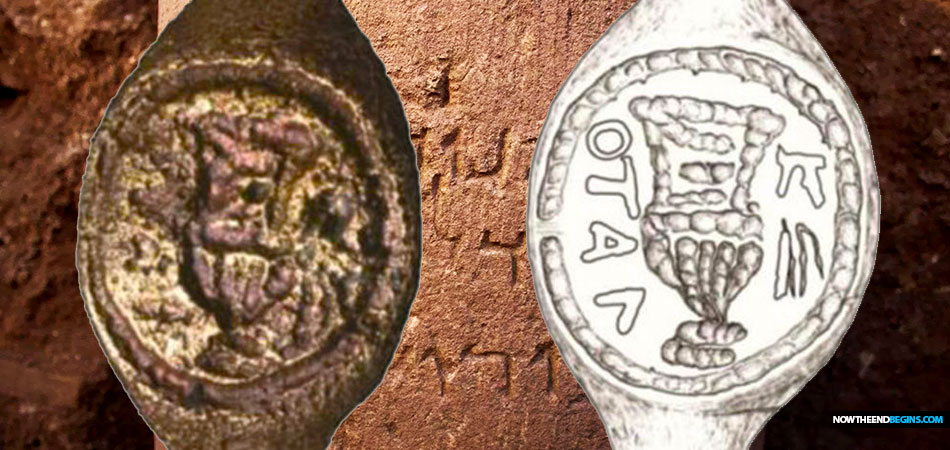
An inscription on a copper-alloy ring that was found nearly 50 years ago at an excavation near Herodium has been deciphered and could have possibly belonged to Pontius Pilate.
Over 50 years ago, at the site of the ancient Herodium in Israel, a ring was found that dated back to the First Century AD. It bore an inscription that until very recently remained undeciphered. Archaeologists have now been able to decode it, and have found that it bears the words 'of Pilate'. Interestingly, Pilate was the 5th of the Roman governors, or prefects, in ancient Judea, and 5 is the number of death and judgment in the Bible. So it is fitting that Pilate would be the one to pronounce death upon the innocent Jesus of Nazareth.
"The kings of the earth stood up, and the rulers were gathered together against the Lord, and against his Christ. For of a truth against thy holy child Jesus, whom thou hast anointed, both Herod, and Pontius Pilate, with the Gentiles, and the people of Israel, were gathered together, For to do whatsoever thy hand and thy counsel determined before to be done." Acts 4:26-28 (KJV)
The Bible tells us that while both Herod and Pontius Pilate were there standing against Jesus, so too were the people of the nation of Israel there to oppose thier king. That opposition continues to this day as you will note in the below article from the JPost. They refuse to give God the glory by using the global standard of BC - which stands for 'before Christ', and AD - meaning 'in the year of our Lord', when referring to Old and New Testament times, and have changed it to BCE - 'before the common era', and CE - 'common era'.
"And Pilate asked him, Art thou the King of the Jews? And he answering said unto him, Thou sayest it. And the chief priests accused him of many things: but he answered nothing. And Pilate asked him again, saying, Answerest thou nothing? behold how many things they witness against thee. But Jesus yet answered nothing; so that Pilate marvelled." Mark 15:2-5 (KJV)
Pray for Israel and the Jewish people, that the scales that cover their spiritual eyes, and that are over their hearts, will be removed and that some might be saved before the start of the
time of Jacob's trouble.
INSCRIPTION REVEALED ON JESUS'S KILLER'S RING
FROM THE JERUSALEM POST: The Roman prefect, who was notoriously credited with the death of Jesus, ruled the Judea province from 26 CE to 36 CE. The inscription, which was published in the latest edition of the
Israel Exploration Journal, includes the words “Of Pilate” [πιλατο] on the
small seal ring dated to the first century BCE to the mid-first century CE.
It also contains a depiction of a krater,
a type of jar that originated in ancient Greecethat was used for watering down wine. The newly published article also discusses the typology of ancient representations of kraters in Second Temple Jewish art.
The
site of Herodium was excavated by Professor Gideon Prester of the Hebrew University of Jerusalem from 1968 to 1969, during which the ring was found at the hilltop palace. Dr. Roi Porat of the Hebrew University headed the exploration of the site’s findings and led the team that worked to clean and examine the ring.
Pilate’s name was not considered to be common during this time, and the seal is typical of the status of cavalry in Roman society, which is why the authors of the publication believe it belonged to the prefect. Though the ring is simple, it was likely to be used for daily functions, such as signing documents by officials or court staff who would have signed documents in Pilate’s name.
Pilate was the fifth of the Roman prefects in Judea. It is assumed by archaeologists that Pilate used Herodium, originally built in the first century CE by King Herod, as an administrative center.
The ring’s study was led and produced by Malka Hershkovitz and Professor Shua Amorai-Stark, and was co-authored by Gideon Foerster, Yakov Kalman, Rachel Chachy and Porat.
According to ancient historian Josephus and canonical gospel accounts, Pilate lobbied for Jesus to be spared his eventual fate of execution, but eventually gave into public demands for his death. He had famously sought to avoid personal accountability for Jesus’s death, as is seen in the Gospel of Matthew with his symbolic “washing of his hands.”
"And Pilate answered and said again unto them, What will ye then that I shall do unto him whom ye call the King of the Jews? And they cried out again, Crucify him. Then Pilate said unto them, Why, what evil hath he done? And they cried out the more exceedingly, Crucify him." Mark 15:12-14 (KJV)
The only other physical archaeological evidence that confirms Pilate’s existence is a Latin inscription found on a limestone block that is Pilate’s tribute to Tiberius. It was found as a reused block within a staircase at the Roman theater in Caesarea, and is now housed at the Israel Museum. The inscription on the stone also references Pilate as prefect of Judea.
READ MORE
No comments:
Post a Comment